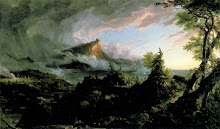Initially, I wanted to write about the train exhibit at the Mitchell Park Domes. I had some vague desire to analyze the odd visual aesthetics of advertisements (on box cars), lovely, blooming azaleas, and lego scenes in conjunction with the ordinary sights and sounds of deafening, runny-nosed children (my own included). Looming over the industrial valley, the giant hot houses form a strange link to the values of the Romantic era in an industrial age. A frequent backdrop for wedding photos, the tropical garden acts as a cheap getaway in February. Despite these interests, I’ve decided to critique Rebel without a Cause instead. Much as I need the riot of azaleas in February, I appreciate bold color and and composition of Rebel as well.
Directed by Nicholas Ray (who hails from Galesville, WI) in 1955, the film marks the beginning of the teen movie genre. The film opens with the protagonist Jim Stark (James Dean) sprawled on the ground playing with a toy monkey while the credits flash over him. Soon after, Jim is picked up by the police and taken to the station. Here, he sees the two other characters that will, with Jim, drive the film’s plot. At the station, all three central characters, Jim Stark (James Dean), Judy (Natalie Wood), and John “Plato” Crawford (Sal Mineo), have problems with inept or absent parents. Because of these problems, these adolescents struggle between opposing forces: isolation and community. In the end, Plato’s problems alienate him while Jim and Judy’s resolve when they forge new relationships. Several links to aesthetic philosophy spring to mind when watching this film, especially in terms of key conflicts and symbolic settings.
Plato, named for the Classical philosopher, grows up without parental love, isolated from his peers. Picked up for shooting puppies on his birthday, Plato and his nanny tell Officer Ray that his mother is often away on vacations. Foreshadowing his own death at the film’s end, the puppy massacre lets viewers in on the depth of Plato’s alienation and self-hatred. Plato later describes his father as a sailor on the China Seas among other stories to explain his absences. Later, when Plato retrieves the gun (Put back after killing the puppies? Nice work, Nanny) in order to protect Jim, he finds a check noted, “For care of son.” In another scene, Plato hangs out in an abandoned mansion, symbolic of his own abandoned home. Clearly, Plato’s parents have some explaining to do, but they never appear in the film.
Because of their total rejection, Plato seeks a father figure in Jim, the new kid in town, whose own problems stem from his weak father and domineering mother. Like Alcibiades looks at Socrates, Plato often looks longingly at Jim, suggesting he desires more than a father. Jim, however, to compensate for his own isolation, tries unsuccessfully to fit in with the cool kids, a violent group led by Buzz Gunderson, Judy’s boyfriend. When they meet at the Planetarium, Buzz and Jim’s square off in a knife fight. Later that night, Jim and Buzz agree to meet at a bluff to play “chicken” with fatal results. Before they get into their cars, Jim and Buzz stand together on the edge overlooking the sea. When Jim asks why they have to compete so dangerously, Buzz responds, “Well, you gotta do something.” Shortly thereafter, Jim survives the game, but Buzz careens off the cliff, leaving his gang leaderless and Judy isolated. The brief attempt at joining the adolescent community fails.
The planetarium and the cliff scenes both link to Kant’s concept of the sublime. Both settings force the teens to confront their own mortality, fears, and insignificance. When they are first at the planetarium for a school field-trip, the speaker’s narration during a simulation of the end of the world echoes Plato’s isolation. “Man existing alone seems himself an episode of little consequence,” he narrates. Plato responds, “What does he know about Man alone?” but he cowers shortly before saying this. The vastness and emptiness of space mimic his inner isolation. This also reminds me of Hegel who describes the spiritual force existing internally in the Romantic man. However, instead of the divine within and without, Plato has internalized his family’s estrangement. At the end of the film, Plato returns to the Planetarium as he tries to escape the police. When Jim tries unsuccessfully to save him, Plato rejects him (for going off with Judy), running out of the building to be shot by the cops. No simulation of the world’s end this time, Plato’s nanny cries, “Poor baby ain’t got nobody.” A far cry from the Hegelian idea of reconciliation, Nicholas Ray’s modern man dies violently and alone.
Like the planetarium, the cliff represents a symbolic setting where the plot turns and Jim shifts his attention to Judy. First, looking over the edge forces the truth out of Buzz and Jim. Here, they confront the stupidity of their actions but to no avail. “I like you,” Buzz says to Jim, out of everyone else’s earshot, of course. After Buzz’s death, Jim pulls Judy back from the edge, suggesting he will save her from despair. By setting these pivotal scenes in nature (or a simulation of it), Nicholas Ray aligns himself with the Romantic era philosophers but with a less hopeful sense of progress.
After Plato's death, Jim introduces Judy to his parents with his arm around her, as their betters. Thus, love bridges the gap between adolescence and adulthood. Plato, however, ends as he begins, without love. Jim and Judy, on the other hand, both find love, the mean between the Platonic extremes of isolation and community. To Nicholas Ray, isolation destroys the individual while the community fails the individual.
Subscribe to:
Post Comments (Atom)
.jpg)
.jpg)
.jpg)
No comments:
Post a Comment